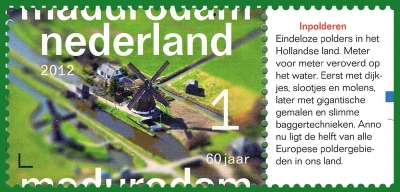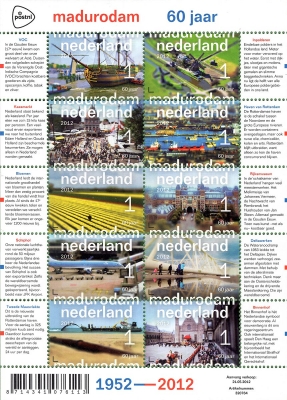-
60 years of the Madurodam Park
Netherlands 2012.05.21
In issue: Stamp(s): 10 Sheet(s): 1
Printing: offset
Issued in: sheets of 10 (2*5) stamps in one series, with coupons describing the subjects of the stamps
-
Number by catalogue: Michel: 2971 Yvert: 2898 Gibbons: 2950
Perforation type: 13 ½x13 ½
Subject:
The sheet contains 10 stamps with no par value.
One of them shows the windmills of the Zanse Schans open-air museum**
Additional:
*Madurodam (Dutch pronunciation: [maˌdyːroːˈdɑm], opened 1952) is a miniature park and tourist attraction in the Scheveningen district of The Hague in the Netherlands. It is home to a range of 1:25 scale model replicas of famous Dutch landmarks, historical cities and large developments. The park was opened in 1952 and has since been visited by tens of millions of visitors. The entirety of net proceeds from the park go towards various charities in the Netherlands. In 2012, Madurodam celebrated its 60th anniversary.
Madurodam was named after George Maduro, a Dutch law student from Curaçao who fought the Nazi occupation forces as a member of the Dutch resistance and died at Dachau concentration camp in 1945. In 1946, Maduro was posthumously awarded the Medal of Knight Fourth class of the Military Order of William, the highest and oldest military decoration in the Kingdom of the Netherlands, for the valor he had demonstrated in the Battle of the Netherlands against German troops.
Mrs B. Boon-van der Starp was a member of a foundation for the Dutch Students Sanatorium. In this sanatorium students with tuberculosis could obtain treatment, and could also study. Financial support was needed to pay for their convalescent care. Mrs Boon-van der Starp heard about Bekonscot, a miniature park in Beaconsfield, England. This park generated large profits, a large part of which was donated to a hospital in London each year.
After a meeting with Mrs Boon-van der Starp, George Maduro's parents donated the funds needed for the Madurodam project, as a memorial to their son. S.J. Bouma was appointed architect of Madurodam, and visited Bekonscot because Mrs Boon-van der Starp wanted the new park to be similar. After his visit he created a plan for Madurodam and came up with a theme: Het stadje met de glimlach ("The little city with the smile").
On 2 July 1952, the then teenage Princess Beatrix was appointed mayor of Madurodam, and was given a tour of her town. When Beatrix became Queen, she relinquished this title. After her resignation a new tradition arose: the city council would annually select a mayor from their midst. All members of the youth council are The Hague students. Every year schools from The Hague can nominate students to take part in the youth council.
The youth council members are also members of the disbursement committee at Madurodam. The disbursement committee manages charities – Madurodam has its own fund which provides financial support to institutions that organize activities for young people.
In 2011, research showing declining public interest prompted the park management to invest in a large-scale renovation, at a cost of €8 million, in time for the park's 60th anniversary in 2012. For this purpose the park was closed to the public between November 2011 and April 2012.
The park is now divided into three themes: water, as a friend and an enemy; historical cities; and The Netherlands as an inspiration for the world. Each theme offers different activities - from light shows to mixing music. Small coin slots trigger bridges, factories or an oil tanker on fire. While aesthetic improvements have been made, the informative aspect has also been improved. Small television stands show brief video footage or in-depth information. Visitors receive chipped cards upon entry, which can be used to trigger these.
On 7 April 2012, Madurodam opened its doors to the public again. The official opening was on 21 April 2012 with former Queen Beatrix.
__________
**Zaanse Schans (Dutch pronunciation: [ˈzaːnsə ˈsxɑns]) is a neighbourhood of Zaandam, near Zaandijk, Netherlands. It is best known for its collection of well-preserved historic windmills and houses. From 1961 to 1974 old buildings from all over the Zaanstreek were relocated using lowboy trailers to the area. The Zaans Museum, established in 1994 near the first Zaanse Schans windmill, is located south of the neighbourhood.
Zaanse Schans derived its name from the river Zaan and its original function as sconce (schans in Dutch) against the Spanish troops during the Eighty Years' War of Dutch independence.
Zaanse Schans is one of the popular tourist attractions of the Netherlands and an anchor point of the European Route of Industrial Heritage (ERIH). The neighbourhood attracted approximately 1.6 million visitors in 2014. It is served by Zaandijk Zaanse Schans railway station, 18 minutes away from Amsterdam Centraal station.
The Zaanse Schans houses seven museums — the Weavers House, the Cooperage, the Jisper House, Zaan Time Museum, Albert Heijn Museum Shop and the Bakery Museum. The whole neighbourhood is a popular tourist attraction and there is a debate in local politics on how to reduce overcrowding.
__________
The information used was taken from Wikipedia
Size (of sheet, booklet) mm: 108x150
Topics: Windmills




